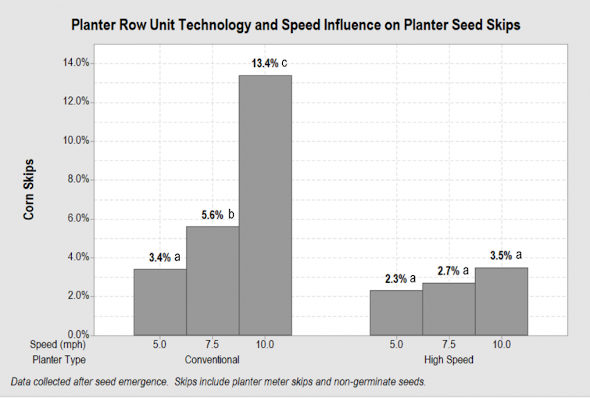By Matt Darr
Recently Iowa State University (ISU) completed a five-year study of high speed planting technology using the Precision Planting SpeedTube and the John Deere ExactEmerge seed meter and seed delivery system. Both planters provided excellent singulation and spacing of corn while planting up to 10 miles per hour (
High Speed Planting Technology Article, Link 1).
In agriculture, it is rare that a single technology will provide a guaranteed yield response every year. Although there are examples like section control (
Precision Ag Technology Savings Article, Link 2), most ag technologies provide different levels of yield and economic impact depending on the growing season. When considering the yield benefits of high speed planting, it’s important to consider two areas where this new technology has an opportunity to enhance yields in a given year.
Plant Spacing and Skips
The most direct influence a planter row unit can have on yield is in its number of seed skips or unplanted seeds. A significant amount of skips will result in a net reduction in overall corn population. In testing conducted at ISU, we observed a significant increase in the number of skips at planting speeds of 7.5 miles per hour and greater when using a conventional vacuum seed meter, compared to a meter designed for high speed operation. The combination of skips produced at the seed meter and skips produced by excessive seed bounce in the drop tube often exceeded 10 percent for a conventional planter meter operating at 10 miles per hour.

Figure 1: Summary of corn skips for conventional and high-speed planting units. Conventional planters significantly increase the amount of skips as planter speed increases. High speed planters are able to maintain a low level of skips at all speeds up to 10 mph. High speed data presented includes both Precision Planting SpeedTube and John Deere ExactEmerge which both produce similar corn spacing results.
Increasing seed meter skips and seed bounce in the drop tube resulted in less consistent seed spacing. As previously discussed (
High Speed Planting Technology Article, Link 1), the standard deviation of seed spacing increased proportionally as planter speed increased with conventional planters. Seed spacing with high speed planters was consistent at all speeds tested, up to 10 miles per hour.
During side-by-side comparisons in the same field planted with the same variety, we observed that high speed planters produced statistical yield advantages ranging from 0 to 3 bushels per acre. While not guaranteed to provide a positive yield response in a single year, improved spacing and reduced skips is a foundation to strong corn production, and high speed planting technology can deliver excellent results over a wider operating range than traditional planter row units.
Timely Planting
The economic benefit of reduced skips and improved corn spacing are only achieved when planting at high speeds. When operated at the manufacturer-recommended speed of approximately 5 miles per hour, the majority of conventional planting systems can achieve high-quality spacing that will maximize yield.
Corn yield potential is influenced by planting date (
Best Corn Planting Dates for Iowa, Link 3). Although the specific date range varies based on where you farm, all regions of the corn belt have date ranges that maximize yield potential. As corn planting extends beyond the optimal planting window, corn yield potential can drop by as much as 3 to 5 percent per week.
If you are one week beyond your optimal window for 20 percent of your corn acres, it will have a net impact of approximately $6 per acre across your farm. For a 1,000-acre corn producer with 200 acres of late planted corn, the average economic impact will be $6,000. While this is certainly not guaranteed in a specific year, there is strong agronomic data to suggest this economic impact is real over the long term.
There are multiple ways to increase planting capacity and plant more corn within the optimal window. This includes using a larger planter, operating multiple planters or planting at a higher ground speed. Each producer decides how to optimize their own operation to balance logistics, cost and labor capacity. For many, choosing high speed planting technology is a way to maintain current equipment size while planting more acres per hour with the same amount of labor.
Recommendations for planting capacity are heavily driven by risk management. Producers should consider if they are planning for a typical planting season, or an overly wet and narrow planting window that may occur once every five years. This decision will be different based on the risk management practices of each producer. High speed planting technologies are simply another way to manage risk, provide growers with another tool for managing narrow planting windows and get more corn planted within the optimal planting period for their region.
Soybean Survival Rate & Yield
In the high speed planting study conducted at ISU (
High Speed Planting Technology Article, Link 1), we found soybean survival rates at harvest are higher when they are planted with a system that can singulate and maintain good spacing, even at high planting populations. The yield advantage of improved singulation and survival rate in soybeans ranged from 0 to 2 bushels per acre in a given year. Results where similar across seeding rates ranging from 100,000 to 160,000 seeds per acre which highlights soybean yield flex across populations. While this result does not suggest a guaranteed financial gain from yield improvement, it does highlight the potential of high speed planting systems, and specifically the improved seed delivery systems, to enable reduced soybean seeding rates to achieve the same at harvest plant density and yield.
Source : iastate.edu